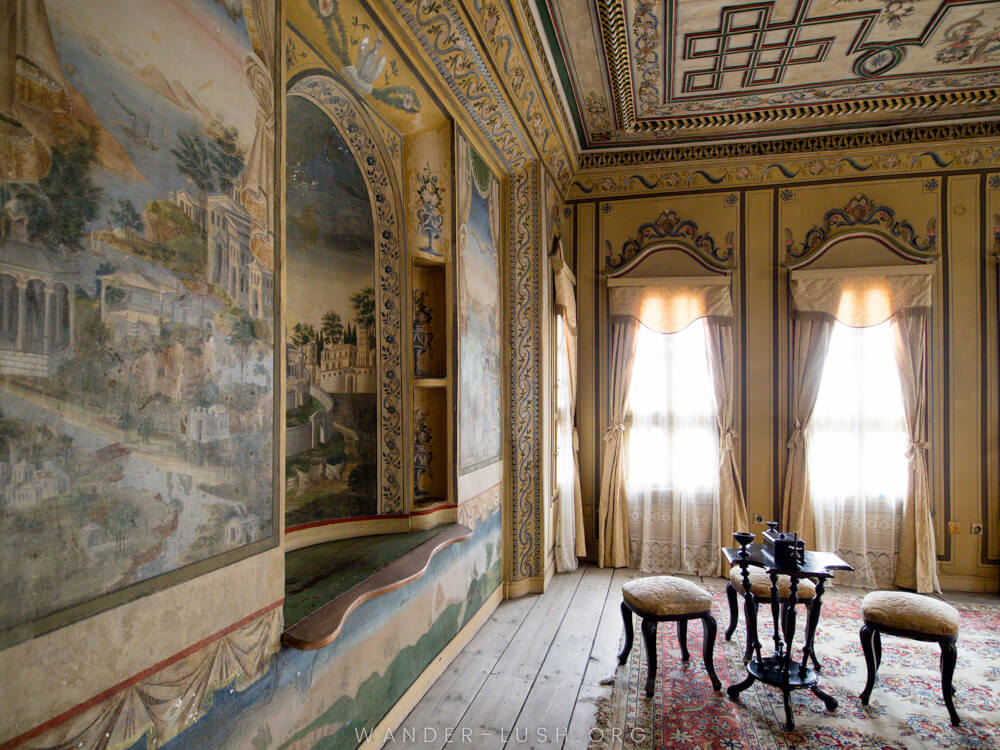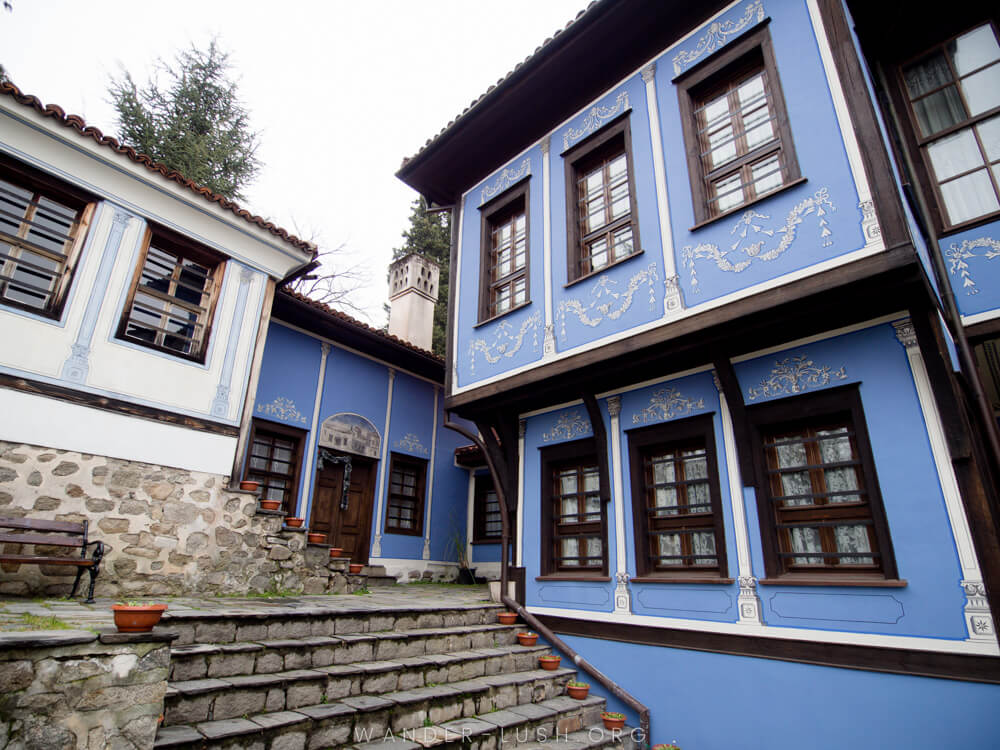A visitor’s guide to Hindliyan House—a National Revival-style home and one of the finest examples of traditional Bulgarian architecture in Plovdiv Old Town.
Hindliyan House (AKA Hindlian House) in Plovdiv, Bulgaria is one of the handsomest private residences I think I’ve ever set foot in. Built by a team of master craftsmen in 1835, the home is a beautiful example of the National Revival Architecture popular among Bulgaria’s merchant class at the time. Detailed wall murals and period furniture—not to mention the one-of-a-kind bathroom—set Hindliyan House apart from its peers and make it my top choice of house museum in Plovdiv.
If you’re drawn to visit Plovdiv, European Capital of Culture in 2019, this is one historical landmark and stellar example of Bulgarian architecture you definitely shouldn’t miss.
In this post, I’ll share a few of my favourite photos of Hindliyan House along with a bit of information I learned about the home’s history. At the end of the post, you’ll find everything you need to know about visiting Hindliyan House for yourself.

Getting acquainted with National Revival Architecture in Plovdiv
If you’re visiting Plovdiv, you’re going to hear the term ‘National Revival Architecture’ spoken quite often. This style of building was a product of the Bulgarian Revival or Renaissance Period, an era of nostalgia-inflected national pride that followed on the heels of Bulgaria’s newly regained independence from the Ottomans in the 18th and 19th centuries.
At the same time as this surge of national pride and unity was gripping Bulgaria, the country was also experiencing significant economic growth. Merchants and traders, at the time Bulgaria’s wealthiest class, started travelling further afield than ever before. Traversing the geographic and ideological boundaries between East and West, they returned to Bulgaria’s cities with new ideas and influences gathered from the world’s cultures.
New wealth combined with outside inspiration led to innovation in Bulgarian art, literature, and architecture. In Plovdiv, a ‘competitive journey’ to build the grandest house ensued among the city’s merchants. Using stone ruins as their foundations, Plovdiv’s wealthiest residents went about adding another layer to Plovdiv’s already rich built environment.
No two Bulgarian National Revival houses are the same. Regional styles were popular, and the layout and decoration changed depending on the climate. There are a few typical design elements you can see across most houses: An upper floor that’s wider than the lower level and supported by wooden beams (as you can see in the photo below); large street-facing plate glass windows; carved wooden ceilings in the main rooms; and opulent painted decorations on the facades.

Who was Stepan Hindliyan?
Among Plovdiv’s merchants was Stepan Hindliyan, the man for whom Hindliyan House was built and named. Born Stepan Manuk in Armenia, the successful trader and landowner’s work took him as far afield as India, which is where he acquired the nickname Hindliyan.
Hindliyan headed one of the four wealthiest Armenian families in Plovdiv, all of whom lived close together in this part of the Old Town and sponsored the construction of some of the city’s most magnificent homes. Hindliyan House was built as a private residence for the patriarch and his family, which included seven sons and daughters. In the entryway of the House Museum you can find a copy of the Hindliyan family tree along with a map that traces Stepan’s journey from Armenia to Plovdiv.

The history of Hindliyan House
Hindliyan House was constructed between 1834 and 1835 by a group of master builders whose names have sadly been lost to history. The house shares a common garden with Balabanov House, another example of National Revival Architecture, and is steps away from Plovdiv’s Armenian Apostolic Church.
The house has two levels: The ground floor was used by the Hindliyan family, while the second level (which has more opulently decorated rooms) was set aside for visitors. Both floors have a similar symmetrical layout. A large common room (called a hayet) is used as a sitting area, with several bedrooms and antechambers branching off on two sides.
One design feature that sets Hindliyan House apart from other homes in the area is the ground floor bathroom. The only washroom of its kind that’s left in Bulgaria, it featured hot running water and a Turkish-style steamroom.
Separate servant’s quarters containing a kitchen and laundry are located outside the main house. This part of the house was closed at the time of our visit, but in summer, the servant’s quarters host pop-up art exhibitions and other events.

Incredible interiors
With its cantilevered window boxes, wooden beams and painted flourishes, Hindliyan House is impressive from the outside. But it’s the interior decorations, which are second to none in Plovdiv, that really steal the show.
It took two artists just six months to finish the interior of the home. Some sources (including the House Museum itself) report that one of the artists was of Italian descent. Others name the artists as Moko and Mavrudi, a famous pair of Bulgarian icon painters from the nearby town of Chirpan.
Every room in Hindliyan House is finished with wooden carvings, painted frescoes and inlay ceilings. Alcoves and entire walls are painted with European motifs that were popular at the time: Piers, flower garlands, vignettes, geometric motifs, and landscape compositions.

The downstairs rooms are boxier and more modestly dressed than the upstairs guest rooms. Hindliyan House is one of the first examples where paper stencils were used by the artists to render the floral motifs on the ground floor’s walls.
One of the grandest spaces is the upstairs hayet hall (pictured below). The water fountain in the painted alcove once flowed with rose water. Yes, Hindliyan was that rich—and he wasn’t afraid to flaunt it.


Alafranga murals
My favourite paintings in the house are the Alafranga murals. As far as I can tell, Alafranga means ‘in the French style’, and was a popular form of decoration at the time Hindliyan House was built. During the Ottoman Empire, Alafranga referred to cultural concepts that toed the line between East and West, antiquity and modernity. This is very apt for Plovdiv, a place that many people describe as an ancient city with a youthful spirit.
There are half a dozen Alafranga murals in Hindliyan House, located in recessed alcoves and above some of the bedroom doors. Each portrays an incredibly detailed and realistic vignette taken from a city in the region: Stockholm, Athens, Lisbon, Istanbul and Venice depicted among them. One of the murals depicts the Lighthouse of Alexandria in Egypt, which was destroyed in 1480.


These trompe l’oeil murals were designed to act as ‘portals’ onto a world far beyond the geographic and cultural boundaries most people of the era lived within. Some of the murals are complete with faux curtains and shutters to emphasise the illusion. One can only assume that the Alafranga were added are an ode to Hindliyan’s success as a merchant and a tribute to his world travels.
The upper bedrooms of the house are roped off so you can’t get a proper square-on view of the Alafranga.
Hindliyan’s own Turkish bathhouse
Hindliyan House was one of few private homes in Plovdiv with hot running water. A network of fireplaces hidden in the walls of the house heated the water and produced steam, while a network of clay pipes underfoot circulated hot air and provided underfloor heating.
Less of a bathroom and more like a mini Turkish bathhouse, the room is finished with marble and plasterwork, and features vaults and a domed roof with honeycomb windows to let natural light in. The alcoves and detailing around the basins is gorgeous.
As soon as we walked into the bathroom, I had flashbacks to our public bath experience in Tbilisi. Just imagine how indulgent a bathhouse with underfloor heating would have been at the time the house was built—especially during a cold Plovdiv winter.

The charming courtyard
Enclosed by a high wall, Hindliyan House faces inward, with a small portico at the main entrance. The interior part of the house’s facade is painted porcelain blue, while the street-facing walls are a rusty red. As is typical of National Revival houses in Plovdiv, Corinthian columns and florid motifs are painted around the doors, windows and corners of the facade.
The house’s service wing, which includes a kitchen, laundry, and servant’s quarters, is located at the rear (on the left in the photo above). A split-level stone courtyard unites the complex and must look beautiful in summer. A lime-lined well in the centre of the courtyard provided filtered rainwater for the household’s use.
The doorway immediately to the left of the main gate as you enter the courtyard is decorated with a miniature painting of the house (pictured above). This is the maaza, a two-storey stone building with a solid iron door where Hindliyan apparently stored objects of value. By some accounts, the maaza was where Hindliyan kept his money. The House Museum caretaker told us that he would lock himself in the house for days in order to count his cash.

How to visit Hindliyan House Museum in Plovdiv
Hindliyan House is located at number 4, Artin Gidikov Street in the central zone of Plovdiv’s historic Old Town. All the major sights in the Old Town are well signposted, so simply follow the arrows and look out for the red-brick coloured house—you can’t miss it. An information plaque marks the main entrance to the courtyard. The house is open to visitors daily from 9am until 5.30pm (or 6pm in summer, April through October).
Entrance to Hindliyan House costs 5 Leva per adult. If you want to take photos inside, you’ll need to pay an extra 5 Leva per camera (this extra camera charge is pretty uniform across all historic homes in Plovdiv, including the Ethnology Museum). If you don’t have time to go inside, the front courtyard is free to visit. Remember it is gated, so you’ll still need to visit during opening hours.
One of Hindliyan House’s knowledgeable, English-speaker caretakers is always on-site to answer visitors’ questions about the property and the Hindliyan family.
More Bulgarian Revival Architecture in Plovdiv
Hindliyan House might be the most beautiful house in Plovdiv (in my books, anyway), but it’s just one of a dozen homes of its kind managed by the Ancient Plovdiv Municipal Institute. The Institute is charged with restoring and protecting the city’s cultural heritage, and also oversees the Roman Theatre and Stadium.
If you enjoyed Hindliyan House and want to see more examples of National Revival Architecture, I recommend adding Balabanov House, Nedkovich House, and Stambolyan House to your Plovdiv itinerary.
Have you visited Hindliyan House? What did you think? Or maybe you’ve seen National Revival Architecture elsewhere in Bulgaria? I’d love to hear your thoughts in the comments below!







